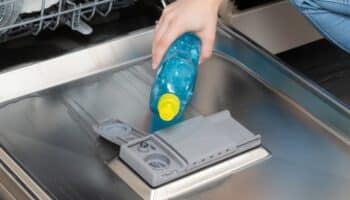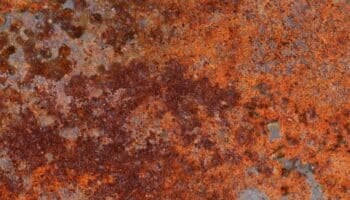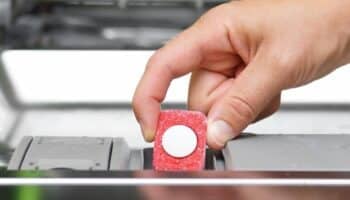We've independently reviewed this article to make sure it's as accurate as we can make it.
To find out more about our article creation and review process, check out our editorial guidelines.
Does your dishwasher keep saying to check the water?
If the dishwasher keeps complaining about water issues, but you notice it’s dryer than desert sand, don’t worry – that’s not unheard of.
This article’ll cover how to address the “check water” notification in two brands – Bosch & Samsung. Also, I’ll guide you through troubleshooting many dishwasher error codes.
If you have a different brand, these same methods can be applied to any dishwasher.
First, try a software reset if your dishwasher has a reset button. If that doesn’t work, try a hard reset by unplugging the dishwasher (or switching off the power) for 5 minutes. If the dishwasher still says “check water,” give it a full cleaning session and check for any sediment blocks.
That’s the quick answer, but there’s more detail than that. Read on to solve the mystery of the check water light!
Why trust us? This article was written by Craig Anderson and James Blackford.
Craig has helped thousands of other homeowners repair their appliances since 2016.
James is one of our resident appliance experts, with over 16 years of experience. He currently works as a Master Technician for SquareTrade, and runs his own appliance repair business.
Solving The Check Water Light
Bosch is one of the brands most likely to present a check water light notification. Whether the check water message appears due to delicate components or careless design, one thing’s for sure – you need to find a solution, pronto.
Bosch Dishwasher Error Codes
Bosch dishwashers can display many error codes, including the one associated with the “check water” message, typically registered under Error Code E04. If your dishwasher shows Error Code E04 on its screen, rest assured that there’s a simple solution.
But before we go into more detail, you must understand what each error code means.
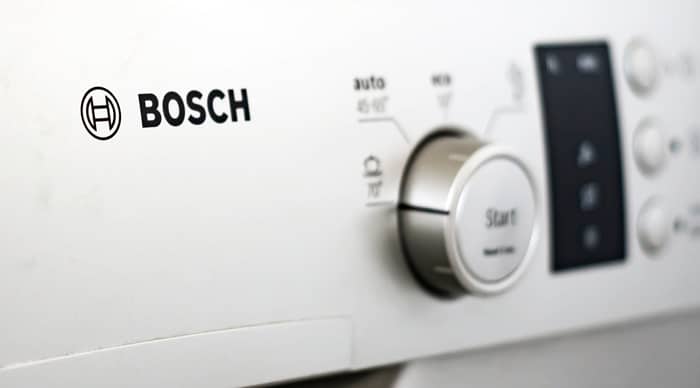
Error Code E04
Error Code E04 means there’s a water flow sensor issue that typically appears due to a clogged inlet valve or a clogged/blocked hose.
In my experience, Error Code E04 can also happen due to software bugs. Don’t worry, though; bugs are still classified as common dishwasher malfunctions.
Solution: To fix Error Code E04, you should start by unplugging the dishwasher for approximately 15 minutes. Use that quarter of an hour to check for clogging or bending in the inlet.
If neither is visible, plug the dishwasher back in and run a full cycle. Assuming you can’t run a cycle, you’ll need to take additional steps to address the issue.
Sometimes, the water in certain areas can be rich in minerals. And while minerals in water might sound like a good thing, it’s not. High mineral content in water contributes to the formation of blocks of sediment that can easily clog your dishwasher, thus promoting you with Error Code E04 and asking your Bosch dishwasher to “check water”.
If you suspect hard water to be the problem, try the following steps to clean your Bosch dishwasher:
- Check the sprinkler and look for sediment blocks.
- If found, remove the sprinkler and hold it under running water.
- Use a toothpick to get to any areas that are difficult to clean.
- Make sure that every component is rinsed thoroughly and has no more sediment.
- If you keep getting Error Code E04, there’s a good chance that you’ll have to replace your appliance’s flow sensor.
Error Code E07
Error Code E07 normally appears when the component that gets water from the inlet to your dishes becomes clogged. Clogging could easily explain a Bosch dishwasher’s “check water” notification.
Resolving Error Code E07 is a little tricky but simple enough for you to try it.
Solution: Here’s what you have to do:
- Drain the water from your Bosch dishwasher.
- Remove the pallets and the filter.
- Remove any food particles or debris from the filter.
- Rinse the filter and put it back into the dishwasher.
In our appliance expert’s experience, 9/10 times these two errors codes (E04 & E07) are related to a bad case break assembly. The assembly is the clear plastic part, usually on the left of the side of the dishwasher, that houses the water level sensor, water flow sensor, overflow sensor, and where the fill and drain hoses connect to.
Repairing the assembly is a simple process that most people can follow – though you’ll need to find your appliance’s tech sheet for model specific replacement instructions.
Error Code E15
Error Code E15 is more of a security measure than an error. It’s usually displayed when excess water is present at the bottom of the appliance. Usually under the water fill valve, sump seal, or drain motor.
When there’s excess water, the safety switch triggers, and Error Code E15 is displayed on your dishwasher’s screen.
If you feel confident enough to check the water levels on your own, more power to you. But if not, I recommend calling someone from Bosch and asking for help.
Solution: Here are some easy steps you can follow should you choose to try the repair yourself:
- Tilt the Bosch dishwasher at a 45-degree angle to the left. The tilting will reset the error code.
- Remove any excess water from the tray.
- Dry the tray thoroughly and put it back into its normal position.
The steps above should address the issue and eliminate the Bosch dishwasher “check water” notification. Please remember that dishwashers are HEAVY, so try getting someone to help you tilt the appliance to avoid injury.
Check Water On Samsung Dishwashers
Samsung dishwashers can display more than 20 error codes, which, in my experience, can make it hard to pinpoint exactly which one you’re getting and why.
Most people won’t ever have to worry about the majority of the error codes on a Samsung dishwasher since some are exclusive to specific models.
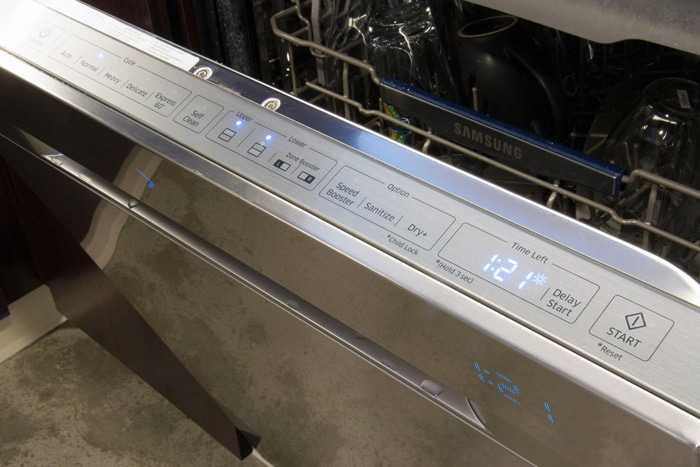
Before diving into the solutions, I’d be remiss not to mention that many Samsung models don’t display an error message per se but show blinking lights in different colors instead. And this also applies to the dishwasher “check water” notification.
The company has stressed that most issues you can encounter with your Samsung dishwasher can be resolved quickly and easily, but you should not wait too long to address them. If ignored for enough time, even a little problem can escalate into a much more concerning and expensive failure.
More often than not, issues with Samsung dishwashers are related to leaks, which can manifest themselves under Error Codes 5C, 5E, 0C, or 0E. These error codes are usually displayed when there is a valve pump seal or drain pump leaking issue.
In some models, valve pump seal damage and drain pump leaking issues could appear as blinking lights above the “Heavy” and “Auto” buttons.
Solution: Here’s how to solve most of these error codes:
- Check the drain hose.
- Make sure that the dishwasher hose is in the proper position.
- Check that there are no twists or bends in the hose.
- Straighten the hose to undo any twists or bends.
- Ensure the check valve is not stuck in the “off” position.
- Run water for at least 30 seconds.
Do you see an error code LE or LC? LE and LC Error Codes indicate moisture detected where it does not belong in your Samsung dishwasher. You may not notice the excess moisture, so do not assume that it is not there just because you cannot see it.
Is there a visible leak? Then the first step is to turn the dishwasher off at the circuit breaker. Inspect the water supply hose for signs of moisture, loose connections, or damage. Signs of damage coming from the water supply hose indicate that you need to replace it.
Once you purchase the replacement hose, follow the installation instructions. If you don’t feel comfortable installing the replacement hose, I recommend you call a qualified professional installer.
If you want to get any replacement part – or see how much one would cost – click to enter your model number in the search bar below. Our partners at AppliancePartsPros stock almost every part with free guides on how to install them.

Another possible reason for the LE or LC error is an issue with the drain hose. Check the drain hose and tighten the connection if you discover it’s not properly connected when you check for leaks.
Do you see other error codes on your dishwasher that indicate a need to perform an inspection related to a check water message or another error? Samsung provides a cool tool with each error code displayed on the page. You simply click the code that you see on your dishwasher.
Learn what each code means and the steps you need to take to fix the issue and make the error code disappear.
Does your Samsung or Bosch dishwasher say to check water or display an error code to check water? These tips can help resolve the dishwasher’s check water issues.
How to Prevent a Dishwasher” Check Water” Notification
Preventing your Samsung or Bosch dishwasher from asking you to “check water” is not always possible, as sometimes this issue will stem from something broken, loose, or faulty. However, you can implement many good practices into your daily routine to keep the “check water” message at bay.
The key habits are:
- Clean the dishwasher regularly: There are many parts inside your dishwasher, such as the filter, that must be cleaned at least twice per month to prevent clogging, bad smells, and improper water drainage.
- Inspect the water hose often: As mentioned earlier, the water hose is a key element to preventing your Samsung or Bosch dishwasher from asking you to “check water”. Ensure to look for any damage, loose connections, or gunk buildup at least once a month to keep everything running smoothly.
- Keep hard water in mind: The water in some areas has more minerals than others. More minerals mean more sediment buildup in your dishwasher’s components, which can lead to clogging and malfunctions over time. Check your dishwasher’s parts frequently and clean the sediment and other obstructions whenever possible. In my experience, water and vinegar are great for cleaning.
Conclusion
That about covers it!
Trying to fix a dishwasher yourself can be intimidating, but I hope this piece has helped you see that, more often than not, doing so is really simple. In most cases, sediment buildup or a leak is to blame, and the steps above should help you patch things up in no time.
Thank you very much for reading. If this article was useful and interesting, please check out our other incredible resources below and consider subscribing to our newsletter.
Happy dishwashing!
-Craig.





